
Organic reaction mechanisms. 1998 / 15
.pdf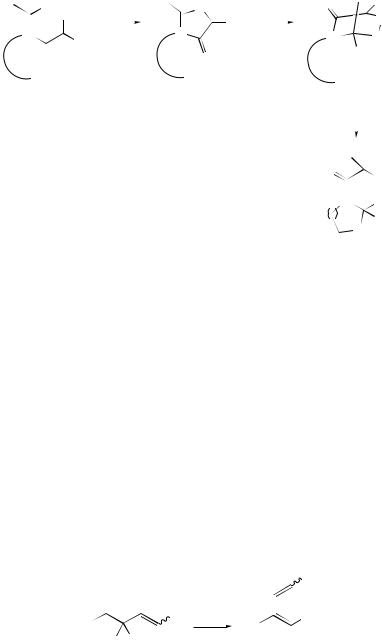
15 Molecular Rearrangements |
|
|
|
|
|
|
|
567 |
||||||
R1 |
O |
1 |
+ |
|
O |
O |
R |
2 |
||||||
|
|
R |
O |
|
|
|
|
|||||||
|
N2 |
|
Rh2+ |
− R2 |
A=B |
|
|
B |
||||||
|
|
|
|
|
|
|
|
|
|
|
||||
|
N |
|
|
R2 |
N |
|
N |
A |
|
|||||
|
|
|
|
|||||||||||
|
|
|
|
|
|
|
|
|
||||||
|
|
|
|
|
|
|
O |
|
|
R1 |
|
|
|
|
|
|
|
|
|
|
|
|
|
|
|
|
|
|
|
|
Nu |
|
|
|
Nu |
|
|
Nu |
|
|
|
|||
|
(254) |
|
|
|
|
|
|
|
|
|
H+ |
|
||
|
|
|
|
|
|
|
|
|
||||||
|
|
|
|
|
|
|
|
|
|
|
|
|||
|
|
|
|
|
|
|
|
|
|
R2 |
OH |
|||
|
|
|
|
|
|
|
|
|
O |
|
|
B |
||
|
|
|
|
|
|
|
|
|
|
|
|
|||
|
|
|
|
|
|
|
|
|
|
N |
|
|
||
|
|
|
|
|
|
|
|
|
|
A |
||||
|
|
|
|
|
|
|
|
|
|
n |
R1 |
|||
|
|
|
|
|
|
|
|
|
|
Nu |
|
|
|
|
|
|
|
|
|
|
|
|
|
|
(255) |
|
|
|
|
SCHEME 83
and various benzocyclopentenyl-carbenes have revealed398 that phenyl carbon migrations are preferred to alternative 1,2-carbon shifts. It has been observed399 that 1,2- vinyl shifts of 1-phenylbut-3-arylidenes [(256) to (257)] proceed with retention of configuration. A theoretical study of the adamantene and protoadamantene systems has been undertaken,400 and adamantylchlorocarbene and its ring-expanded product chlorohomoadamant-3-ene have been characterized401 by matrix isolation spectroscopy combined with DFT calculations. The latest results on the metal-induced 1,2-alkyl shifts in cyclic syn α-hydroxy epoxide systems have been reported.402 They have shown that the reaction proceeds via a carbenoid intermediate (258) which can rearrange along two distinct intramolecular carbenoid insertion routes to yield two regioisomeric α,β-unsaturated ketones (see Scheme 84). A carbene-type intermediate (260) has been invoked403 to account for the unusual base-promoted rearrangement of (E)- 1-benzyloxy-2,3-epoxyalkanes (259) to allylic alcohols (261) (see Scheme 85).
A bis(dithia-dication) dimer has been proposed404 as an intermediate in the remote oxygen migration reactions of 1,4-bis(methylthio)benzene and its derivatives (see
••
Ph
R R
(256)
R
R  R
R
Ph
R (257)
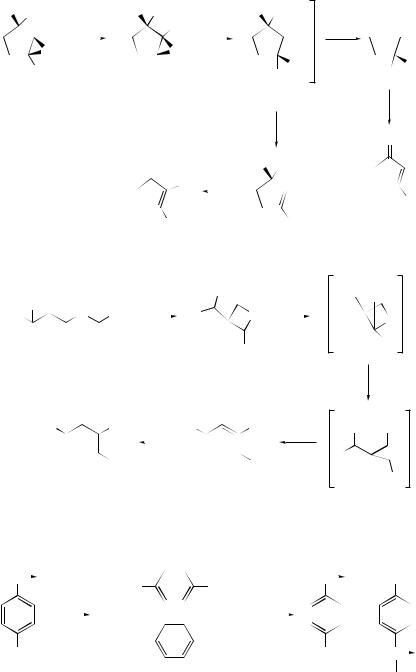
568 |
Organic Reaction Mechanisms 1998 |
HO R |
|
|
LiO R |
|
LiO R |
|
|
2 BunLi |
|
|
Li |
|
• |
|
|
|
|
|
||
|
|
|
|
|
|
• |
O |
|
|
O |
|
||
|
|
|
|
|||
R′ |
|
|
R′ |
|
R′ OLi |
|
|
|
|
|
|
(258) |
|
|
|
|
O |
|
|
|
|
LiO R |
|||
|
|
|
|
|
|
R′ |
|
|
|
R′ |
|
|
|
|
|
|
|||||||
|
|
|
|
|
R |
|
OLi |
||||
|
|
|
|
|
|
SCHEME 84 |
|
|
|
||
|
|
|
|
|
|
|
OH |
|
|
|
|
|
O |
|
R′Li |
|
R |
|
|
|
|||
R |
O |
Ph |
|
O |
|
|
|||||
|
|
|
|
|
|||||||
|
(259) |
|
|
|
|
|
|
|
Ph |
||
|
|
|
|
|
|
|
|
|
|||
R |
Ph |
|
R |
Ph |
|
OH |
|
OLi |
OLi |
|
|
|||
|
OH |
|
|
|
|
(261) |
|
|
|
|
|
|
SCHEME 85 |
|
OLi

 R
R
OLi
R′
O
 R
R
R′
OLi
R Li
Li
O
Ph
LiO• • • Li O
O
R•
•
Ph
(260)
CD3 |
|
|
|
|
|
|
|
|
|
CD3 |
CD3 |
||||||||||||
|
|
|
|
|
|
+ |
|
+ |
|
|
|
|
|
|
|
|
|
|
|
|
|||
S |
|
O |
|
|
|
|
S |
|
O |
S |
|||||||||||||
|
|
|
|
||||||||||||||||||||
|
|
|
|
|
Me |
|
S |
|
S |
|
Me |
+ |
|
|
|
|
|||||||
|
|
|
|
|
|
|
|
|
|
|
|
||||||||||||
|
|
|
|
|
|
|
|
|
|
|
|
|
|
|
|
|
|
|
|
|
|
|
|
|
|
|
|
|
|
|
|
|
|
|
|
|
|
|
|
|
|
|
|
||||
|
|
|
|
|
|
|
|
|
|
|
|
|
|
|
|
|
|
|
|||||
|
|
|
|
|
|
|
|
|
|
|
|
|
|
|
|
|
|
|
|
|
|
|
|
|
|
|
|
|
|
+ |
+ |
|
|
|
|
|
|
|
|
|
|
|
|
||||
|
|
|
|
|
Me |
|
S |
|
S |
|
Me |
|
|
|
|
|
|||||||
|
|
|
|
|
|
|
|
|
|
|
|
|
|||||||||||
SMe |
|
|
|
|
|
|
|
|
|
SMe |
S |
|
O |
||||||||||
|
|
|
|
|
|
|
|
||||||||||||||||
Me
SCHEME 86
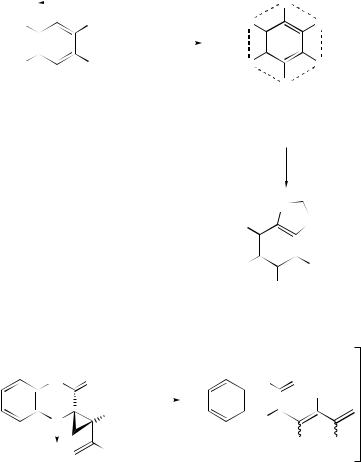
15 Molecular Rearrangements |
|
|
|
|
569 |
|||||
|
|
|
|
|
|
|
Me |
|
|
2+ |
|
|
|
|
|
|
|
|
|||
|
|
|
|
|
|
|
|
|
|
|
O |
|
SMe |
|
|
|
S |
|
|
|
|
|
|
|
|
|
|
|
||||
MeS |
|
SMe |
|
|
MeS |
SMe |
|
|||
|
|
|
H2SO4 |
|
|
|
|
|
|
|
|
|
|
|
|
|
|
|
|||
|
|
|
or |
|
|
|
|
|
|
|
|
|
|
|
|
|
|
|
|||
|
|
|
|
|
|
|
|
|||
MeS |
|
SMe (CF3SO2)2O |
|
|
MeS |
SMe |
|
|||
|
|
SMe |
|
|
|
S |
|
|
|
|
|
|
|
|
|
|
|
Me |
|
|
|
|
(262) |
|
(263) |
2X− |
||||||
X = HSO4, CF3SO3 |
S |
+ |
|
|
|
MeS |
|
SMe X− |
|
|
|
MeS |
|
SMe |
|
||
|
||
|
SMe |
|
|
(264) |
|
Me |
|
|
|
|
|
|
Me |
|
|
|||
|
|
O |
|
|
|
|
|
|
|
|||
N |
|
|
N |
O |
R1 |
|||||||
|
|
|
|
X2O |
|
|
|
|
|
|
||
|
|
|
|
|
|
|
||||||
|
|
|
R1 |
|
|
+ |
|
|
||||
S |
|
|
||||||||||
|
|
|
||||||||||
|
|
|
|
|
|
S |
|
|
||||
|
|
|
|
|
|
|
|
|
XO− |
H |
R2 |
|
O |
R2 |
|
|
|
||||||||
|
|
|
|
|
|
|
||||||
(265) |
X = Ac, CF3CO |
(266) |
|
|||||||||
|
|
|
|
|
|
|
|
|||||
Scheme 86), and a σ -delocalized hexathia dication (263) is considered405 to be the most stable intermediate for the Pummerer-type rearrangement of (262) into (264). The Pummerer reaction of 2-vinylcyclopropyl sulfoxides (265) has been shown to proceed via butadienyl thionium ions (266) by the proton abstraction from the 2 - methyl group or the cyclopropane ring, to yield cyclic dienes or acyclic dienols.406 Benzyl 2-(hydroxymethyl)phenyl sulfoxides on treatment with p-toluenesulfonic acid monohydrate have been found to undergo a Pummerer-type rearrangement to afford benzaldehydes. The reaction was found to proceed via an oxosulfonium salt as an intermediate.407 The potential of both additive and vinylogous Pummerer reactions of amido sulfoxides for the preparation of nitrogen-containing heterocycles has

570 |
Organic Reaction Mechanisms 1998 |
been demonstrated.408 A new synthesis of the 1,4-dioxahydrindane ring system has been reported409 using a novel double deprotective-double cyclization rearrangement sequence mediated by aqueous HF. The process is considered to involve fluorideinduced desilylation of both silyl ethers followed by an acid-catalysed double cyclization and finally a Pummerer-type rearrangement, in which the sulfoxide moiety becomes protonated and undergoes subsequent dehydration to give thionium ion (267). A deprotonation and subsequent protonation then produces oxonium ion (268) which is trapped with water (see Scheme 87).
O |
|
|
|
Ph + OH |
|
|
|
|
|
|
|
|
|
|
|
|
|
|
S |
|
S |
|
OTBS |
|
|||
Ph |
|
|
|
O |
−H2O |
|
|
|
|
||||
|
|
|
|
|
||
|
|
|
|
|
|
|
H |
• |
|
O |
|||
|
|
|||||
|
|
|||||
|
|
|
|
|||
|
|
|||||
|
OTBS |
|
||||
Ph |
|
Ph |
|
S |
|
S |
|
OH |
|
H + |
|
O |
H2O |
O |
H+ |
O |
|
O |
|
|
|
(268) |
|
Ph  S+
S+
 O
O
O
(267)
Ph
H+ |
S |
•• |
|
|
O |
|
O |
SCHEME 87
The mechanism of phenylseleno-etherification of unsaturated alcohols, which involves seleniranium cationic intermediates, has been studied410 by the semiempirical molecular orbital MNDO–PM3 method.
Rearrangements in Natural-product Systems
A comparison has been made411 of various monoterpenoid rearrangements catalysed by either zirconium phosphates or by zirconium organo-substituted phosphonates, and acid-catalysed rearrangements of α-trans- and β-cis-3,4-epoxycaranes have been described.412 It has been observed413 that on exposure to Li (OBut )3AlH, perhydro- naphthalene-1,4-diol monosulfonate ester (269) rearranges to the 11-oxatricyclo- [5.3.1.0.2,6]undecane derivative (270) (see Scheme 88).
Parthenin (271) has been found to undergo a skeletal rearrangement with the introduction of acetate functionality414 [see (272)] upon treatment with Ac2O–H2SO4. An
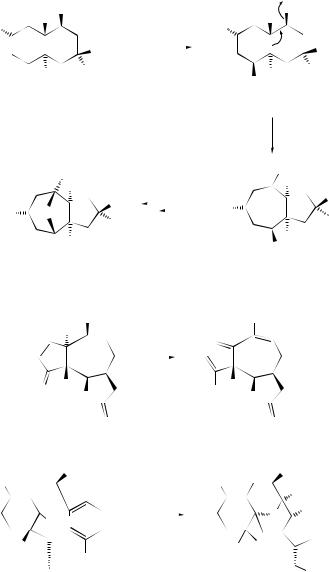
15 Molecular Rearrangements |
|
|
571 |
||
|
Me |
OMS |
|
OMS |
|
|
|
|
Me |
|
|
AcO |
|
|
AcO |
|
|
|
|
Me |
Li(OBut)3AlH |
Me |
|
|
|
|
|
||
|
H |
Me |
|
O− H |
Me |
|
|
||||
O |
|
|
|
||
(269) |
|
|
Li(OBut)3Al+ |
|
|
|
|
|
Me |
|
|
|
|
|
|
|
|
|
|
Me |
|
|
|
|
|
|
|
|
|
|
|
|
|
|
|
H |
|
||
|
|
|
H |
|
|
|
|
|
|
|
|
|
|
|
||
|
|
|
|
|
|
|
|
|
|
+ |
|
Me |
||||
|
|
|
Me |
|
|
|
|
|
|
|
|
|||||
|
|
|
|
|
|
|
|
|
|
|
|
|
|
|
||
|
|
|
|
|
|
|
|
|
AcO |
|
||||||
AcO |
O |
|
|
|
|
|
|
Me |
||||||||
|
|
|
|
|
|
|||||||||||
|
|
|
|
|
|
|
|
|
|
|
|
|||||
|
|
|
Me |
|
|
|
|
|
|
|
|
|
|
|
|
|
|
|
|
|
|
|
|
|
|
|
|
|
|
|
|
|
|
|
|
|
H |
|
|
|
|
|
|
|
|
|
|
H |
|
|
|
|
|
|
|
|
|
|
|
|
|
|
|
O− |
|
||
|
|
|
|
|
|
|
|
|
|
|
|
|
|
|
||
|
|
(270) |
|
|
|
|
|
|
|
|
Li(OBut)3Al+ |
|
||||
|
|
|
|
SCHEME 88 |
|
|
|
|
|
|
||||||
|
|
|
Me |
|
|
|
|
|
|
|
|
|
Me |
|
||
|
|
|
OH |
|
|
|
|
|
|
|
|
|
|
|
|
|
|
|
O |
Me |
|
|
|
|
|
|
AcO |
Me |
|
||||
|
|
|
|
|
|
|
|
|
||||||||
|
|
|
O |
|
|
|
|
|
|
|
|
|
O |
|
||
|
|
|
O |
|
|
|
|
|
|
|
|
|
|
O |
|
|
|
|
|
(271) |
|
|
|
|
|
|
|
(272) |
|
|
|
||
Me |
|
OAc |
|
|
|
|
|
|
Me |
|
|
|
OAc |
|
||
|
|
|
|
|
|
|
|
|
|
|
|
Me |
|
|||
|
|
|
|
|
|
|
|
|
|
|
|
|
|
|
|
|
|
|
|
Me |
|
|
|
|
|
|
|
|
|
|
|
H |
|
|
|
|
|
|
|
|
|
|
|
|
|
|
|
|||
|
|
|
MeMe |
|
|
|
|
|
|
|
|
|
|
O |
|
|
|
|
|
|
|
|
|
|
|
|
|
|
|
|
|||
|
|
|
|
|
|
|
|
|
|
|
|
|
|
|
|
|
|
|
|
|
|
|
|
|
|
|
|
|
|
|
|
|
|
HO |
|
Me |
|
|
|
|
|
|
|
Me Me |
|
|||||
|
|
|
|
|
|
|
|
|
|
|
|
|
|
|
|
|
|
|
OCOC6H4NO2(p) |
|
|
|
|
|
|
|
|
|
|
|
|
HgCl |
|
|
|
(273) |
|
|
|
|
|
|
|
(274) |
|
|
||||
unexpected rearrangement–transannular cyclization product (274) has been obtained415 on treatment of bicyclo[9.3.1]pentadecatriene (273), a precursor of taxol, with mercuric triflate. A Wagner–Meerwein rearrangement of rings B and C of the clovane skeleton has been explored416 by deuterium labelling of 9 α-bromo-2β-methoxyclovane. The formation of isocomene (276) and modhephene (277) in the solvolytic rearrangements

572 |
|
|
|
|
|
|
|
Organic Reaction Mechanisms 1998 |
|
|
Me |
|
|
|
|
|
|
|
|
Me |
H |
H |
|
|
|
|
Me |
Me |
|
|
|
|
|
|
|
|
|
|
|
|
Me |
OMs |
|
|
|
Me |
Me |
Me |
|
|
|
|
|
||||||
|
Me |
|
|
|
|
|
|
Me |
Me |
|
|
|
|
|
|
|
Me |
||
|
|
|
|
|
|
|
|
||
|
|
|
|
|
|
|
|
|
|
|
H |
|
|
|
|
|
|
|
|
|
(275) |
|
|
|
|
|
|
(276) |
(277) |
|
Me |
H |
|
|
|
|
|
Me |
OH |
|
|
|
|
|
|
|
|||
|
|
|
|
|
Me |
H |
H |
||
|
Me |
H |
|
|
|
|
|
Me |
|
|
|
|
|
|
|
|
|||
|
|
|
|
|
|
|
Me |
|
|
|
|
|
|
|
|
|
|
|
|
|
|
TsO |
|
|
|
|
|
H |
|
|
|
|
|
|
|
|
|
|
|
|
|
(278) |
|
|
|
|
|
(279) |
|
S • SnBu3
• SnBu3
 N
N
O N
Me 
Me 
CO2Me
(280)
of silphinyl mesylates (275) and from the acid-catalysed conversion of silphinene, has provided417 experimental precedent for the biogenetic linkage of these triquinane sesquiterpenes. 15-Norcaryophyllen-8-β-yl tosylate (278) has been found to undergo a stereospecific rearrangement–cyclization to 12-nor-8α-presilphiperfolan-9-β-ol (279) upon solvolysis in aqueous acetone. Although the ring bond that participates in the cyclobutylcarbinyl–cyclopentyl rearrangement is unknown, the reaction has provided a chemical precedent for a biogenetic connection between caryophyllene and the presilphiperfolanols.418
It has been shown419 that isomerization of the exocyclic allylic system of the fivemembered ring D of kaurenols depends on the orientation of the C(15) hydroxyl group. The total synthesis of methyl atis-16-en-19-oate, a tetracyclic diterpenoid possessing a bicyclo[2.2.2]octane skeleton, has been accomplished420 using a homoallyl-homoallyl radical rearrangement process of methyl 12-hydroxykaur-16-en-19-oate monothioimidazolide (280) as the pivotal step. Two plausible mechanisms have been presented421

15 Molecular Rearrangements |
|
|
|
|
573 |
||||
|
OPP |
|
|
Me |
|
|
|||
|
|
|
|
|
|
||||
|
Me Me |
|
Me |
D |
|
||||
|
D |
|
+ |
|
H |
:B |
|||
|
|
|
|
||||||
|
|
|
|
|
|
|
|
||
Me |
Me |
Me |
Me |
|
|
||||
|
|
a |
|
|
b |
|
|
||
|
|
|
|
|
|
||||
|
Me |
|
|
Me |
|
|
|||
|
|
|
|
|
|||||
|
+ |
|
|
|
|
|
|
|
|
|
|
|
|
|
|
|
|
|
|
|
CH2D |
|
Me |
|
D |
||||
|
Me |
|
|
||||||
|
H |
|
|
|
|
|
H + B |
||
|
|
|
|
|
|
||||
|
H |
|
|
|
|
|
|||
Me |
Me |
Me |
Me |
|
|
||||
|
|
|
|
|
|
(281) |
|
|
|
Me
CH2D
Me
H
Me Me
SCHEME 89
(see Scheme 89) for the novel cyclization-rearrangement of (+)-copalyl diphosphate to (−)-abietadiene which is catalysed by recombinant cyclase from Abies grandio. However, further research is required to elucidate whether the mechanism involves an intramolecular C(14) to C(16) hydrogen-transfer pathway (path a), or an enzymemediated proton elimination to form a pimara-8(14),15-diene intermediate (281) that incorporates the proton at C(16) (path b). The structure of a naphthalene derivative obtained by rearrangement of 13-methoxytotara-5,8,11,13-tetraen-7α-ol has been revised422 to 5-(5 -isopropyl-6 -methoxy-2 -methyl-1 -naphthyl)-2-methylpent-2-ene.
The involvement of a common concerted mechanistic pathway for the acidcatalysed cyclization of 5,6-unsaturated oxiranes, viz. (282) to (283), in chemical and enzymatic systems has been demonstrated,423 and indeed, theoretical evidence has been produced424 to show the participation of a concerted mechanism for oxirane cleavage and A-ring formation in oxidosqualene cyclization. Further
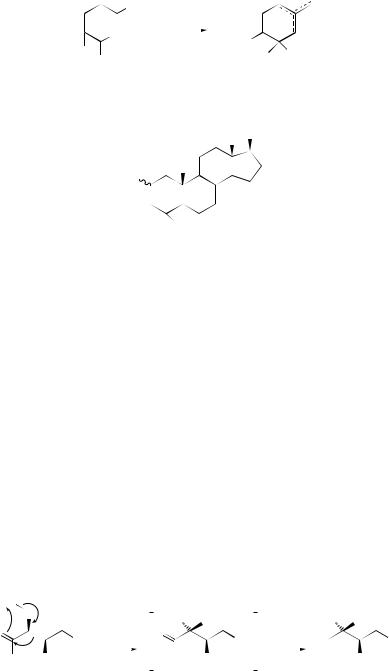
574 |
|
|
|
Organic Reaction Mechanisms 1998 |
|
|
|
Me |
|||
|
|
|
HA |
||
|
|
|
|||
Me |
|||||
|
|
HO |
|||
O |
|
|
|||
|
|
Me Me |
|||
Me |
|
|
|||
|
|
|
|||
(282) |
|
(283) |
|||
Me C8H17
Me
TsO
Me Me
(284)
evidence has been obtained425 to suggest that the polycyclization reaction by oxidosqualene–lanosterol cyclase proceeds via the expansion of a fiveto a sixmembered ring for C-ring formation of lanosterol. 6-Methyl-3-isopropyl-A,19- dinorcholesta-6,8,10(5)-triene has been identified as a new by-product from the acid-catalysed reaction of 4,4-dimethylcholest-5-en-3-one. A novel enone-benzene rearrangement has been invoked426 to account for the formation of this product. A number of 4-hydroxyestrogens have been prepared by the thermal rearrangement of steroidal 4,5-epoxides.427 Sigmatropic and/or contact-ion-pair processes have been invoked428 to explain the observed rearrangement products obtained on the acetolysis of the epimeric tosylates (284). Pinacol rearrangements of 2α,3β,19α- trihydroxyurs-12-triterpenoids have been studied,429 the peracid-induced oxidative rearrangement of bauerenyl acetate has been investigated,430 and a novel oxidative skeletal rearrangement of ring A of lupenone has been described.431 The rearrangement of steroidal α, β-unsaturated pyridine N -oxides with acetic anhydride has been shown to afford diastereoisomeric 20-acetoxy-17-picolyl-16-androstene derivatives.432
It has been established433 that the leaves of Liriodendron tulipifera convert 1-deoxy- D-xylulose (285) into 2-C-methyl-D-erythritol (286) via a skeletal rearrangement (see Scheme 90) reminiscent of the formation of terpene precursors from 1-deoxy-D-xylulose 4-phosphate. An esterase-catalysed regioselective 6-deacylation of
H |
|
|
|
|
|
|
|
|
O |
|
|
HO |
Me |
|
|
HO |
Me |
|
|
|
|
|||||
|
|
|
|
|
||||
O |
|
|
O |
OH |
|
|
|
OH |
OH |
|
|
|
|
|
|
||
Me OH |
|
|
H |
OH |
|
|
OH |
OH |
(285) |
|
|
|
|
|
|
|
(286) |
|
|
|
|
|
|
|
||
|
|
|
SCHEME 90 |
|
|
|
||

15 Molecular Rearrangements |
|
|
|
|
575 |
|
HO |
|
|
+ |
|
Me |
• • |
|
|
|
|
HO |
||
AcO |
O |
H+ |
HO |
|
O |
O |
|
||||||
|
||||||
|
|
|||||
|
|
|
|
AcO |
||
AcO |
|
|
|
|
||
|
OAc |
|
|
|
|
OAc |
|
OAc |
|
|
|
|
OAc |
AcO
O
HO
AcO

OAc
OAc
O
BnO
BnO

OBn
OMe
|
OH H |
|
|
Me |
+O |
O |
|
O |
|||
|
|
AcO

OAc
OAc
SCHEME 91
|
|
|
BnO |
|
|
Ti(OPri)Cl3 |
|
|
BnO |
OBn |
|
|
|
|
O |
||
|
|
|
OMe |
||
|
|
|
|
||
|
|
|
|
Ti |
|
|
|
|
|
|
|
O
BnO
BnO

OBn
OMe
SCHEME 92
hexopyranose peracetates has been reported. Moreover, utilization of the propensity of acyl groups to migrate under acidic conditions (see Scheme 91) has ultimately made possible the conversion of C(6) partially acylated monosaccharides into the corresponding C(4) deprotected species, thus providing a simple method for the regiospecific deprotection of the C(4) position of hexopyranosides.434 A novel stereoselective approach to polyhydroxylated cyclohexanones has been described,435 starting from benzylated 6-deoxy-hex-5-enopyranosides and promoted by titanium(IV) (see Scheme 92). 2,3-Unsaturated monoand di-saccharide glycosylglycerol derivatives have been obtained in good yields by the Lewis acid-catalysed allylic
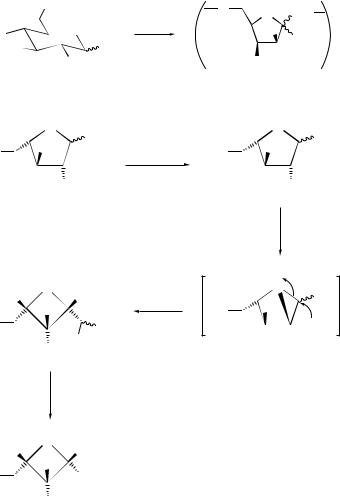
576 |
|
|
|
Organic Reaction Mechanisms 1998 |
|
|
NH2 |
|
|
N |
O CH2 |
|
|
|
|
||
|
O |
|
LiCO3 |
H |
HO |
HO |
|
|
|||
HO |
OH |
HOAc |
|
OH |
|
|
|
|
|
||
|
OH |
|
HO |
n |
|
|
(287) |
|
|
(288) |
|
|
S |
SBn |
|
|
S |
|
|
|
|
OAc |
|
BnO |
OBn |
|
Hg(OAc)2 |
BnO |
OBn |
|
|
|
|||
|
|
|
|
|
|
|
OH |
|
|
|
OH |
|
|
|
|
|
DAST |
|
|
|
|
|
+ |
|
S |
H |
|
|
S |
|
H |
|
|
OAc |
|
|
OBn |
|
|
BnO |
OBn |
BnO |
|
OAc |
|
|
F− |
F
H
S
H H
OBn
BnO |
CHO |
H
SCHEME 93
rearrangement reaction of various glycals with glycerol derivatives436 and other O-nucleophiles.437 The synthesis of a new aminopolysaccharide (288) having an amino-ketose structure, has been achieved438 utilizing the thermal polymerization of 6-amino-6-deoxy-D-glucose (287) in the presence of acetic acid. The novel Lewis acid-catalysed rearrangement of a sugar-base hybrid to afford an anhydronucleoside has been reported,439 and the attempted intermolecular addition of malonyl radicals to 1 , 2 -unsaturated nucleosides has been found to lead to furanones.440 An unusual ring contraction–rearrangement has been observed441 during the attempted fluorination of thiofuranose derivatives with diethylaminosulfur trifluoride (DAST). Scheme 93
